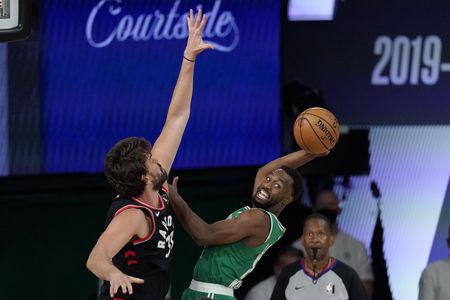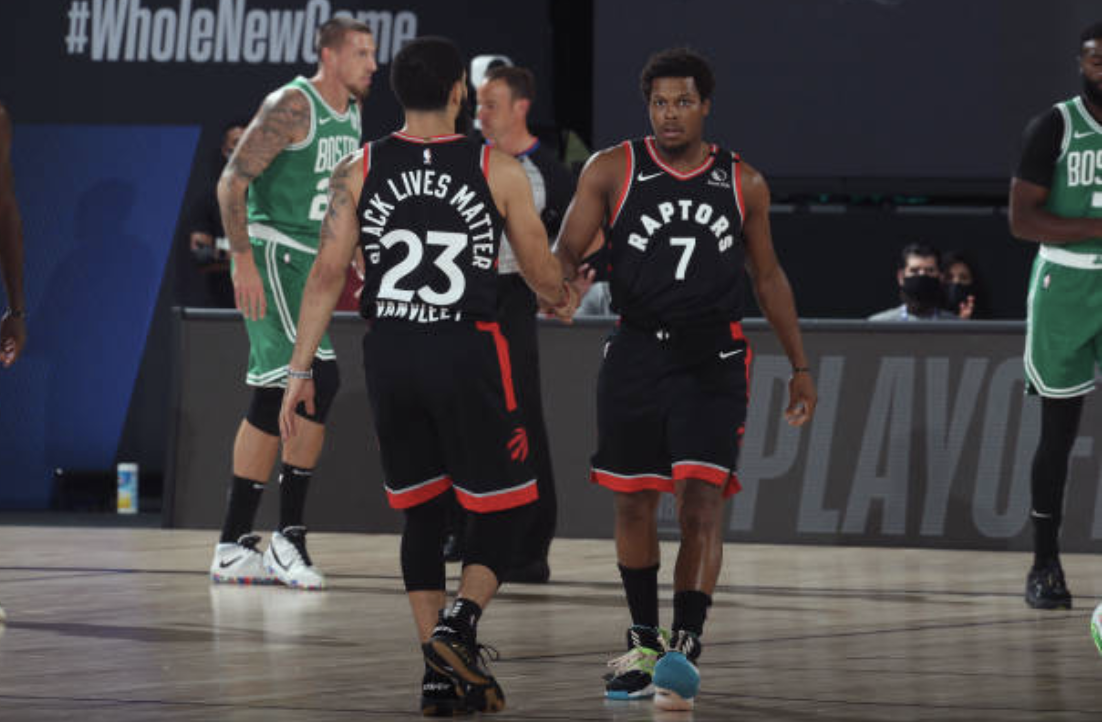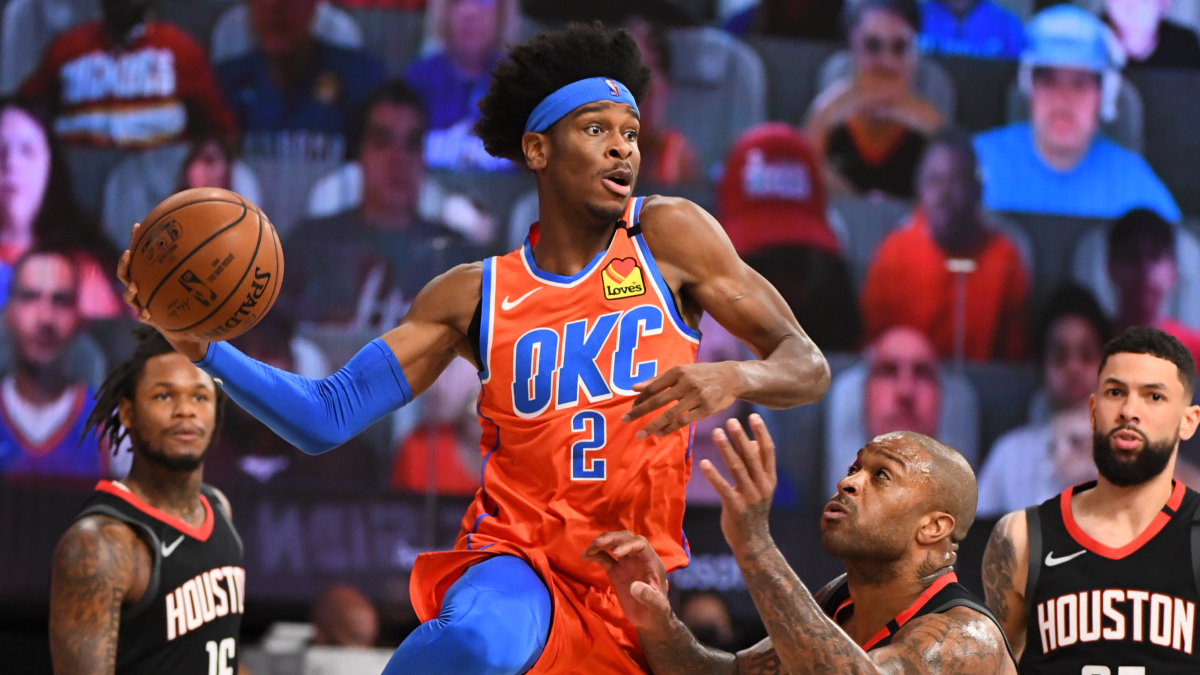Before we dive into the concept of process versus outcome, let’s run through some of the more noteworthy events from the first three games.
Things that have been “cool” in the Raps-Celtics Series
The Incredible OG
OG Anunoby on hitting the game-winner: "It was cool" pic.twitter.com/d87LxEywCr
— TSN (@TSN_Sports) September 4, 2020
“It was cool”. That’s what The Incredible OG had to say when asked about his game-winning shot that saved the Raptors season. You know what else is cool? OG’s reaction to said shot. He now stands beside Jay Wright and his 2016 National Championship winning reaction as the two James Deans of buzzer beaters.

Kyle Lowry
Even a brief discussion of Game 3 would be remiss if it didn’t mention Kyle Lowry. The man is a winner. And in the biggest game of the season thus far, he did absolutely everything in his power to do just that. He may often be the smallest guy on the floor, but he more than makes up for that by being one of the greatest competitors that’s ever played the game.

Serge and OG consolidating all Raptors’ fans’ feelings into one single play
It’s rare that a single moment can sum up 142 minutes of game-time. Serge and OG managed to do just that, when Ibaka rifled the ball off the bottom of the rim straight into OG’s face.

Marcus Smart flopping
Since I don’t have a section about things that have been “uncool” about the Raps-Celtics series, I’ll have to put this here. For any non-Raptors fans reading this – yes, I know Lowry flops. And no, I don’t care. Nobody is perfect. And of the 7,432,561 incredible things that make Kyle Lowry, Kyle Lowry, this is his lone blemish.
Getting back to Smart’s flopping – it was fantastic to see the NBA fine him $5,000 for his Game 2 actions. I’d be surprised if he tries anything like that again after such a stern punishment. What??? You mean you don’t think docking him 0.04% of his salary will discourage him from diving at his next opportunity? Huh, maybe you’re right.

Process vs Outcome
Many people tend to forget that a significant aspect of any sport is variance. This is most true in low scoring sports such as baseball or hockey. Over the course of a season the variance tends to even out. However, come playoff time it can play an important role in determining the eventual champion (think Kawhi’s buzzer-beater vs the 76ers). There is a reason that Billy Beane, former GM of the Oakland A’s, once stated, “My sh*t doesn’t work in the playoffs. My job is to get us to the playoffs. What happens after that is f*cking luck”. While this is less true in basketball, game-to-game shooting variances can still mean the difference between victory and defeat. And it’s especially true in the playoffs, when elite competition means that, for teams like the Raptors, the once ample margins become razor-thin.
It’s obvious to say that the goal of a basketball game is to score more points than your opponent. However, in pursuit of that goal there are items which are mostly within your control, and ones which are largely outside of your control. In basketball, as with most areas of life, it’s wise to focus your attention on the items you can control. At a granular level, there are thousands of controllable events occurring within a basketball game.
- Did the ball handler set-up his defender properly for the upcoming ball screen?
- Did both he and the screener make the correct read based on how their opponents defended the screen?
- Were they both able to execute the resulting actions with the skill and precision necessary to create an offensive advantage?
These are only a few examples of granular, controllable events on a given possession that lead to the most important, high-level, controllable event: Did your team’s offence produce an efficient shot attempt? No matter what the answer is to that question, the controllable aspects of the possession are completed prior to the shot attempt going up. That’s the process.
The outcome of the shot attempt (assuming the ball wasn’t turned over) is now essentially up to chance. If the shot attempt is a wide open Van Vleet three-pointer it has approximately a 45% chance of going in (percentage courtesy of NBA.com). If it’s a tightly contested 12-foot Ibaka floater taken after seven dribbles, the percentage is significantly lower. Despite that, there’s still a chance that the Van Vleet three clangs out while the Ibaka prayer goes in. In that case, the possession which you are more satisfied with depends on whether you are focused on process or on outcome.
Through three games versus the Celtics, the Raptors have been superior on process and inferior on outcome. Cleaning the Glass has developed a metric called Location Effective Field Goal Percentage (LeFG%). It divides the court into segments and assumes that shots from each segment are made at league average percentages (this approach does have some shortcomings which we will address a bit later on). LeFG% can be considered the process portion of the game, while eFG% is the outcome. Below are the LeFG% and eFG% stats for Games 1-3. Positive differences indicate an eFG% higher than LeFG% (outcome was better than process), while negative differences indicate the opposite.

While the teams’ eFG% have varied significantly, LeFG% has been reasonably stable. This is consistent with the theory that often what our eyes see as a difference in quality of play is largely teams simply making or missing shots. The above table also displays the significant shooting variance that existed in Game 1, and to a lesser extent in Game 2.
We can apply the LeFG% to the number of field goal attempts for each team, to arrive at the number of points each team should have scored from the field based simply on process.

It’s then easy enough to incorporate free throws. If we assume that each player makes free throws at his regular season percentage, we can calculate expected points scored from the free throws attempted in each game. Adding the expected points from field goals and free throws provides us with an expected game score.

This analysis suggests that the Raptors were superior on process in each of the first three games. However, as mentioned above, LeFG% clearly doesn’t capture all aspects of a shot attempt. PBPStats has a measure called Shot Quality, which is in the same vein as LeFG%, but also considers factors such as the time remaining on the shot clock, whether the attempt is off an offensive rebound, and how the possession originated. Using the Shot Quality metric in the same fashion as LeFG% produces the following expected game scores. Once again, the Raptors process was better in all three games.

If you’re still following at this point, you may be thinking that neither of these metrics takes into consideration the player who attempted the shot or how closely he was guarded. In order to keep this piece a reasonable length, I won’t go too much farther into the statistical weeds. However, both of those pieces of information are readily available (closest defender can be found at NBA.com). And neither of these factors seems to help explain the significant differences we’ve seen between expected score and actual score through the first three games. The majority of the shooting variance in this series has been from three, and as we can see from the below table, the Raptors have actually attempted a higher percentage of open threes through three games than have the Celtics.

While posting a higher expected score than your opponent doesn’t change the wins and losses in the series, it does indicate that the Raptors may have deserved better results based on their quality of play – which is a positive sign for the remainder of the series.
This is not to say that every single problem in this series has been related to missing shots. There are numerous other issues. They include, but are not limited to:
- The Celtics having three of the four best players in the series thus far
- The Raptors struggling to score in the half-court (as many people anticipated)
- The Celtics realizing that any time Marc Gasol is more than 8 feet away from the basket they can play 5-on-4
- Nick Nurse’s realization part-way through Game 3 that there were only four to five players on the team he could trust
- Related to the last two points, the fact that two of the supposed main Toronto advantages coming into the series (Gasol & Ibaka vs. Theis & Williams, and bench play/depth) have now swung towards Boston
Speaking of issues…
Spicy Pete
Pascal Siakam is one Raptor that has not deserved a better result based on his quality of play. If you’re curious about the origin of Spicy Pete, continue reading. If a tangent to discuss a weird nickname in the middle of a basketball article is not your cup of tea, please skip over the next two paragraphs. This is kind of like a “choose your own adventure”, except instead of choosing between throwing your dagger at the dragon and summoning your death rattle spell, you get to choose between reading the next two paragraphs and not. I wish I had better choices to offer you – I’m sorry about that.
I watched one of the games from the Raptors 2019 title run at a small house party. Of the fifteen or so attendees, only a few of us knew anything about the team. Even though it was a poor game for Pascal, a massive block at a key moment caused our small group to erupt into calls of “SPICY PEEEEEEE”. One of the non-fans was half-watching the game nearby. As we debriefed after the game, the non-fan chimed in with “I thought that play by Peter was really the turning point”. When quizzed as to who Peter was, the non-fan hesitantly answered with “Number 43….the guy that you all called ‘Spicy Pete’.”
As Pascal struggled through a third straight game against the Celtics, it became clear to me that Spicy Pete was not just a funny nickname created during a half-drunken misunderstanding. He was actually Pascal’s identical twin brother. Off the court you would never be able to tell them apart, but on the court it’s very clear to anyone watching that Peter did not get the athletic genes in the family.
Unlike the other Raptors’ regulars, Siakam’s Shot Quality (courtesy of PBPStats) during the Celtics series has fallen off a cliff.
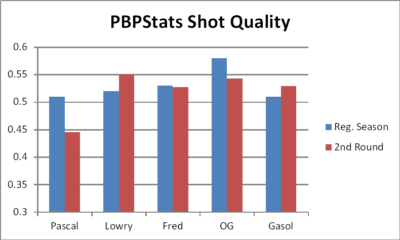
This change in Shot Quality is tied very closely to his shot location. In the regular season the majority of his attempts were within five feet of the rim or from three. During the Celtics series he has been forced to live in the mid-range.

(Courtesy of NBA.com)
This shift in shot location is partially due to the Celtics defence and partially due to the Raptors offensive approach.
Boston is perfectly happy to let Siakam catch the ball in the mid-post or just inside the three. In fact, in the first clip Tatum essentially dares Siakam to shoot.

When Siakam does attack through the post, mid-post, or isolation, the primary Boston defender (often Brown) is strong enough to wall-up and hold his ground, and long enough to effectively challenge or block any jump hook or turn-around. In addition, everyone off the ball is stationary, meaning Celtic defenders can dig confidently knowing they have a clean route back to their check should a kick-out occur. More off-ball movement during a post-up could occupy defenders, giving Siakam wider driving lanes.

To make matters worse, Toronto’s choice of actions really isn’t doing Siakam any favours. He would greatly benefit from either catching the ball on the move, or receiving a ball screen. Either option could give Siakam the slight initial advantage which can be the difference between a successful or failed offensive possession. Instead, his post-ups and isolations have increased significantly in the playoffs, while his ball screen usage has plummeted.
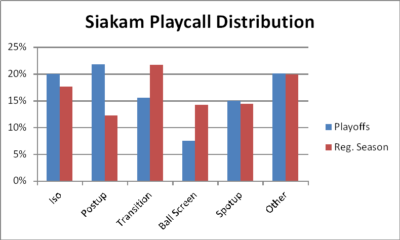
It’s “cool” that the Raptors are back in the series, and their shot quality relative to Boston certainly provides hope for a comeback. But in order to win three of the next four games, the Raptors will need to rediscover their depth, regain their advantage at the centre position, or even better, sub Spicy P back in to replace his twin brother, Spicy Pete.

